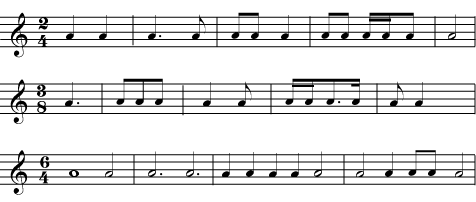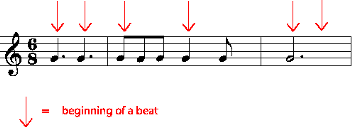2.3: Time Signature
- Page ID
- 1423
- The time signature on a musical staff tells you the meter of the music by defining both the number of beats in a measure and the type of note that fills one beat.
In common notation, the time signature appears at the beginning of a piece of music, right after the key signature. Unlike the key signature, which is on every staff, the time signature will not appear again in the music unless the meter changes. The meter of a piece is a repetitive rhythmic pulse that underlies the music. The time signature is the symbol that tells you what meter is being used in a piece of music and what types of note) are being used to write it out.

Beats and Measures
Music happens over a period of time, so a very common way to organize music is to divide that time into short periods of the same length, using audible pulses called beats. Each pulse is a beat, and the regular, predictable pulse of a piece of music is the beat. The beat is created when the musicians do things (like hit a drum, strum a guitar, or start singing a word) at very regular intervals. This creates an audible, predictable pulse that helps the musicians to coordinate what they are doing so that they sound good together. The predictability and audibility of the beat also allows others to join in. As soon as listeners can "feel the beat," they can clap hands, snap fingers, tap their feet, nod their heads, march, dance, or sing along "in time" with the music (in other words, coordinated with the musicians). Anything that happens during the audible pulse (a clap or drum hit, for example), as well as anything that starts during a pulse (such as a sung word, or a note on a flute or violin) is said to be on the beat. Of course, things can happen in between the beats, too, but the timing for those is also coordinated using the beats; for example, a note might begin at exactly the halfway point between two beats.
Not all music has beats and a time signature. In music with a free rhythm or meter, there is no time signature, and no regular pulse to the music; the musicians are free to play or sing a note at whatever time they feel is best. Other pieces may have a written time signature, to help the musicians keep track of time, but the musical events in the piece do not give it an audible beat.
When music is organized into beats, it makes sense to write it down that way. In common notation, the composer assigns a particular kind of note to be one beat long. For example, if "a quarter note gets a beat," then playing many quarter notes in a row would mean playing a new note on every beat. The quarter note is most likely to play this role, but any type of note can get the "this is one beat" designation.
In most metered music, some of the beats are stronger (louder, more powerful, more noticeable, or busier), than others, and there is a regular pattern of stronger and weaker beats, for example, strong-weak-weak-strong-weak-weak, or strong-weak-strong-weak. So the beats are organized even further by grouping them into bars, or measures. (The two words mean the same thing.) For example, for music with a beat pattern of strong-weak-weak-strong-weak-weak, or 1-2-3-1-2-3, a measure would have three beats in it. The time signature tells you two things: how many beats there are in each measure, and what type of note gets a beat.
Reading the Time Signature

Listen again to the music in Example 1. Instead of clapping, count each beat. Decide whether the music has 2, 3, or 4 beats per measure. In other words, does it feel more natural to count 1-2-1-2, 1-2-3-1-2-3, or 1-2-3-4-1-2-3-4?
Solution
- A has a very strong, quick 1-2-3 beat.
- B is in a slow (easy) 2. You may feel it in a fast 4.
- C is in a stately 4.
- D is in 3, but the beat may be harder to feel than in A because the rhythms are more complex and the performer is taking some liberties with the tempo.
Reading Time Signatures
Most time signatures contain two numbers. The top number tells you how many beats there are in a measure. The bottom number tells you what kind of note gets a beat.

You may have noticed that the time signature looks a little like a fraction in arithmetic. Filling up measures feels a little like finding equivalent fractions, too. In "four four time", for example, there are four beats in a measure and a quarter note gets one beat. So four quarter notes would fill up one measure. But so would any other combination of notes and rests that equals four quarters: one whole, two halves, one half plus two quarters, a half note and a half rest, and so on.
If the time signature is three eight, any combination of notes that adds up to three eighths will fill a measure. Remember that a dot is worth an extra half of the note it follows. Listen to the rhythms in Figure 4.

Write each of the time signatures below (with a clef symbol) at the beginning of a staff. Write at least four measures of music in each time signature. Fill each measure with a different combination of note lengths. Use at least one dotted note on each staff. If you need some staff paper, you can download this PDF file.
- Two four time
- Three eight time
- Six four time
There are an enormous number of possible note combinations for any time signature. That's one of the things that makes music interesting. Here are some possibilities. If you are not sure that yours are correct, check with your music instructor.

A few time signatures don't have to be written as numbers. Four four time is used so much that it is often called common time, written as a bold "C". When both fours are "cut" in half to twos, you have cut time, written as a "C" cut by a vertical slash.

Counting and Conducting
You may have already noticed that a measure in four four time looks the same as a measure in two two. After all, in arithmetic, four quarters adds up to the same thing as two halves. For that matter, why not call the time signature "one one" or "eight eight"?

Or why not write two two as two four, giving quarter notes the beat instead of half notes? The music would look very different, but it would sound the same, as long as you made the beats the same speed. The music in each of the staves in Figure 8 would sound like this.

So why is one time signature chosen rather than another? The composer will normally choose a time signature that makes the music easy to read and also easy to count and conduct. Does the music feel like it has four beats in every measure, or does it go by so quickly that you only have time to tap your foot twice in a measure?
A common exception to this rule of thumb is six eight time, and the other time signatures (for example nine eight and twelve eight) that are used to write compound meters. A piece in six eight might have six beats in every measure, with an eighth note getting a beat. But it is more likely that the conductor (or a tapping foot) will give only two beats per measure, with a dotted quarter (or three eighth notes) getting one beat. In the same way, three eight may only have one beat per measure; nine eight, three beats per measure; and twelve eight, four beats per measure. Why the exceptions? Since beats normally get divided into halves and quarters, this is the easiest way for composers to write beats that are divided into thirds.



